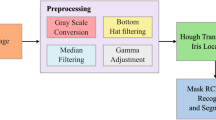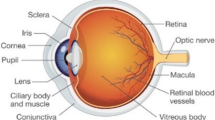Abstract
In the current world scenario the influence of the COVID19 pandemic has reached universal proportions affecting almost all countries. In this sense, the need has arisen to wear gloves or to reduce direct contact with objects (such as sensors for capturing fingerprints or palm prints) as a sanitary measure to protect against the virus. In this new reality, it is necessary to have a biometric identification method that allows safe and rapid recognition of people at borders, or in quarantine controls, or in access to places of high biological risk, among others. In this scenario, iris biometric recognition has reached increasing relevance. This biometric modality avoids all the aforementioned inconveniences with proven high efficiency. However, there are still problems associated with the iris capturing and segmentation in real time that could affect the effectiveness of a System of this nature and that it is necessary to take into account. This work presents a framework for real time iris detection and segmentation in video as part of a biometric recognition system. Our proposal focuses on the stages of image capture, iris detection and segmentation in RGB video frames under controlled conditions (conditions of border and access controls, where people collaborate in the recognition process). The proposed framework is based on the direct detection of the iris-pupil region using the YOLO network, the evaluation of its quality and the semantic segmentation of iris by a Fully Convolutional Network. (FCN). The proposal of an evaluation step of the quality of the iris-pupil region reduce the passage to the system of images with problems of out of focus, blurring, occlusions, light changing and pose of the subject. For the evaluation of image quality, we propose a measure that combines parameters defined in ISO/IEC 19794-6 2005 and others derived from the systematization of the knowledge of the specialized literature. The experiments carried out in four different reference databases and an own video data set demonstrates the feasibility of its application under controlled conditions of border and access controls. The achieved results exceed or equal state-of-the-art methods under these working conditions.









Similar content being viewed by others
References
Agarwal S, Du Terrail JO, Jurie F (2019) Recent advances in object detection in the age of deep convolutional neural networks. ffhal-01869779v2f
Bansal A (2020) Iris recognition system: a review. Int Res J Eng Technol (IRJET) 07:05
Bobrovsky A, Galeeva M, Morozov A, Pavlov V, Tsytsulin A (2019) Automatic detection of objects on star sky images by using the convolutional neural network. J Phys: Conf Ser 1236:1066
Chai TY, Goi BM, Hong YY (2020) End-to-end automated iris segmentation framework using U-net convolutional neural network. Lecture Notes in Electrical Engineering, vol 621. Springer, Singapore
Daugman J (2004) How iris recognition works. IEEE Trans Circ Syst Video Technol 14(1):21–30
Daugman J, Downing C (2016) Iris image quality metrics with veto power and nonlinear importance tailoring. In: Rathgeb C, Busch C (eds) Iris and periocular biometric recognition. IET Publisher, pp 83–100
De Marsico M, Nappi M, Riccio D, Wechsler H (2015) Mobile iris challenge evaluation (MICHE)-I, biometric iris dataset and protocols. Pattern Recogn Lett 57:17–23
Garea-Llano E, Morales-González A, Osorio-Roig D (2019) Video iris recognition based on iris image quality evaluation and semantic classification.CIARP2019. LNCS 11896:198–208
Garea-Llano E, Osorio-Roig D, Hernández O (2018) Image quality evaluation for video iris recognition in the visible spectrum. Biosensors and bioelectronics open access (ISSN: 2577–2260)
Hollingsworth K, Peters T, Bowyer K (2009) Iris recognition using signal-level fusion of frames from video. IEEE Trans Inf Forens Secur 2009(4):837–848
Hosseini MS, Araabi BN, Soltanian-Zadeh H, Pigment M (2010) Pattern for iris recognition. IEEE Trans Instr Meas 2010(59):792–804
Jalilian E, Uhl A (2017) Iris segmentation using fully convolutional encoder–decoder networks. Deep learning for biometrics. Springer, Berlin, pp 133–155
Jia Y, Shelhamer E, Donahue J, Karayev S, Long J, Girshick R, Guadarrama S, Darrell T (2014) Caffe: Convolutional architecture for fast feature embedding. In Proc. of the 22nd ACMMM2014, pp. 675–678
Liao S, Zhu X, Lei Z, Zhang L, Li SZ (2007) Learning multi-scale block local binary patterns for face recognition. In Proc. ICB’07, pp 828–837
Liu W et al (2016) SSD: single shot multibox detector. In: Leibe B, Matas J, Sebe N, Welling M (eds) Computer vision—ECCV 2016, LNCS, vol 9905. Springer, Berlin
Liu N, Li H, Zhang M, Liu J, Sun Z, Tan T (2016) Accurate iris segmentation in non-cooperative environments using fully convolutional networks. In Proc. Int’l Conf. on Biometrics (ICB’16). IEEE, 2016, pp. 1–8.
Lowe DG (2004) Distinctive image features from scale-invariant key points. Int J Comput Vision 2004(60):91–110
Minhaz M, Rahman U, Hasan M, Taief AM (2021) A new framework for video-based frequent iris movement analysis towards anomaly observer detection. Int J Image Graph Signal Process 13(1):13–27
Monteiro C, Oliveira HP, Rebelo A, Sequeira AF, Mobbio A (2013) 1st biometric recognition with portable devices competition. Available in: https://paginas.fe.up.pt/~mobbio2013/.
Naz S, Ziauddin S, Shahid A (2019) Driver fatigue detection using mean intensity, SVM, and SIFT. Int J Interact Multimed Artif Intell 5(4):86–93
Osorio-Roig D, Morales-Gonzalez A, Garea-Llano E (2017) Semantic segmentation of color eye images for improving iris segmentation. In: Proc.CIARP’17. LNCS. Springer, pp. 466–474.
Osorio-Roig D, Rathgeb C, Gomez-Barrero M, Morales-González Quevedo A, Garea-Llano E, Busch C(2018) Visible wavelength iris segmentation: a multi-class approach using fully convolutional neuronal networks. BIOSIG 2018, IEEE.
Pavlov VA, Galeeva MA (2019) Detection and recognition of objects on aerial photographs using convolutional neural networks. J Phys Conf Ser 1326:012038
Proenca H (2016) Unconstrained iris recognition in visible wavelengths. In: Bowyer WK, Burge JM (eds) Handbook of iris recognition, 2nd edn. Springer, London, pp 321–358
Proenca H, Alexandre LA (2010) Iris recognition: analysis of the error rates regarding the accuracy of the segmentation stage. Image vis Comput 28(1):202–206
Proenca H, Alexandre L (2012) Toward covert iris biometric recognition: experimental results from the nice contests. IEEE Trans Inf Forens Secur 7(2):798–808
Proenca H, Filipe S, Santos R, Oliveira J, Alexandre LA (2010) The ubiris.v2: A database of visible wavelength iris images captured on-themove and at-a-distance. IEEE Trans Pattern Anal Mach Intell 32(8):1529–1535
Raja KB, Raghavendra R, Vemuri VK, Busch C (2015) Smartphone based visible iris recognition using deep sparse filtering. Pattern Recogn Lett 2015(57):33–42
Raja KB, Raghavendra R, Busch C (2015) Iris imaging in visible spectrum using white LED. In proc. BTAS 2015, IEEE.
Redmon J, Farhadi A (2017) YOLO9000: better, faster, stronger IEEE Conference on Computer Vision and Pattern Recognition (CVPR) 7263–7271.
Redmon J, Farhadi A (2018) YOLOV3: An incremental improvement,’’ 2018, arXiv: 1804.02767. [Online]. Available: https://arxiv.org/ abs/1804.02767
Redmon J, Divvala S, Girshick R, Farhad A (2016) You only look once: unified, real-time object detection. In 2016 IEEE Conference on computer vision and pattern recognition (CVPR), Las Vegas, pp. 779–788
Sankowski W, Grabowski K, Napieralska M, Zubert M, Napieralski A (2010) Reliable algorithm for iris segmentation in eye image. Image vis Comput 28(2):231–237
Schmid N, Zuo J, Nicolo F, Wechsler H (2016) Iris quality metrics for adaptive authentication. In: Bowyer KW, Burge MJ (eds) Handbook of iris recognition, 2nd edn. Springer, London, pp 101–118
Simonyan K, Zisserman A (2014) Very deep convolutional networks for large-scale image recognition, arXiv preprint arXiv: 1409.1556
Tan C-W, Kumar A (2013) (2013), Towards online iris and periocular recognition under relaxed imaging constraints. IEEE Trans Image Processing 22(10):3751–3765
Tan T, He Z, Sun Z (2010) (2010), Efficient and robust segmentation of noisy iris images for non-cooperative iris recognition. Image vis Comput 28(2):223–230
Torrey L, Shavlik J (2009) Transfer learning. Handbook of research on machine learning applications. Springer, Berlin
Verma S, Girdhar A, Jha RRK (2018) Real-time eye detection method for driver assistance system. Advances in intelligent systems and computing, vol 696. Springer, Singapore
Viola P, Jones M (2004) Rapid object detection using a boosted cascade of simple features. Mitsubishi Electric Research Laboratories Inc, Cambridge
Waleed SA, Fathy A, Ali HS (2018) Entropy with local binary patterns for efficient iris liveness detection. Wirel Person Commun 102(3):2331–2344
Zhao Z, Kumar A (2015) An accurate iris segmentation framework under relaxed imaging constraints using total variation model. In Proc. IEEE Int’l Conf. on Computer Vision (ICCV’15), 2015, pp. 3828–3836.
Zuo J, Schmid NA (2008) An automatic algorithm for evaluating the precision of iris segmentation. In: BTAS’08, Washington, DC, USA
Acknowledgements
This work is an extension and continuity of the results presented by us at the 24th Iberoamerican Congress on Pattern Recognition (CIARP 2019): Garea-Llano E., Morales-González A., Osorio-Roig Video Iris Recognition Based on Iris Image Quality Evaluation and Semantic Classification, Proceedings. Lecture Notes in Computer Science 11896, Springer 2019, ISBN 978-3-030-33903-6. We want to thank the third author of this cited work, Daile Osorio-Roig for her contribution to the conception of the idea that gave rise to the development of the results presented here.
Author information
Authors and Affiliations
Corresponding author
Additional information
Publisher's Note
Springer Nature remains neutral with regard to jurisdictional claims in published maps and institutional affiliations.
Rights and permissions
About this article
Cite this article
Garea-Llano, E., Morales-Gonzalez, A. Framework for biometric iris recognition in video, by deep learning and quality assessment of the iris-pupil region. J Ambient Intell Human Comput 14, 6517–6529 (2023). https://doi.org/10.1007/s12652-021-03525-x
Received:
Accepted:
Published:
Issue Date:
DOI: https://doi.org/10.1007/s12652-021-03525-x




